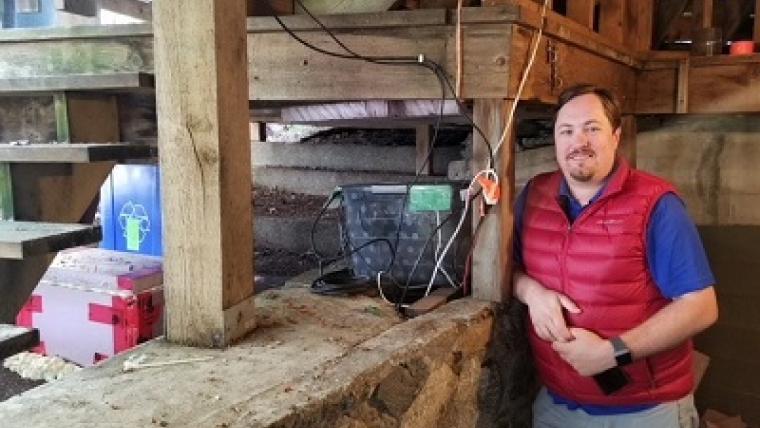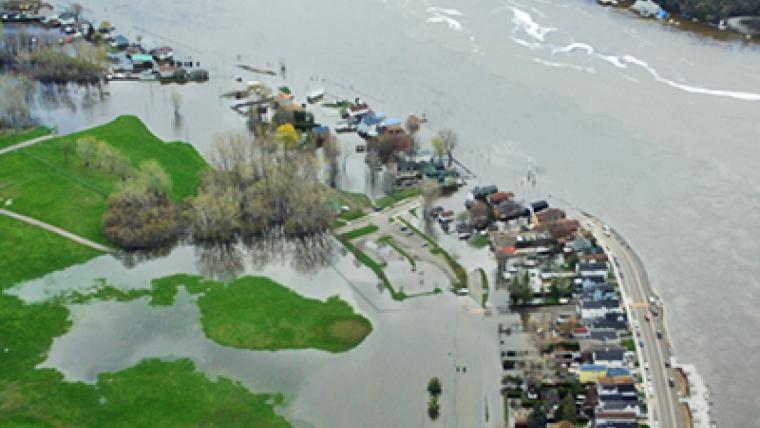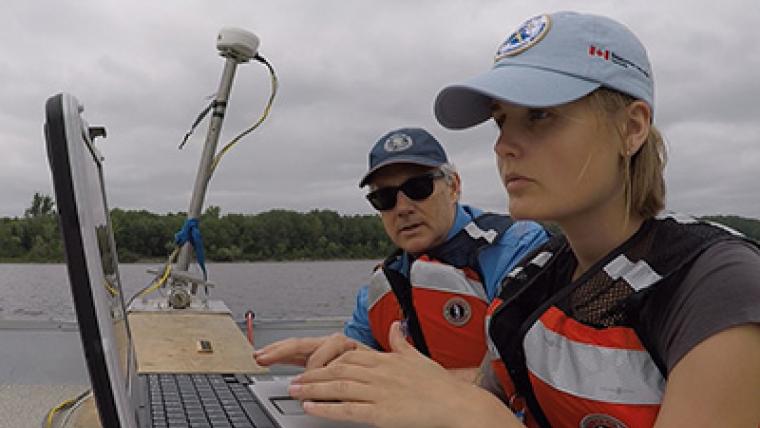Can We Predict Earthquakes? (Ask NRcan)
This episode is all about earthquakes. We are joined by seismologist John Cassidy who explains what causes earthquakes, where they are more likely to occur, and he answers the big question: “can we predict them?”
Transcript
Joel Houle:
Welcome, everyone, to Ask NRCan. I'm your host, Joel Houle, and this our podcast series where we sit down and talk with our experts about their work here at Natural Resources Canada, or NRCan for short.
On this episode, we're talking earthquakes. We have a seismologist who will explain what causes earthquakes, where they're more likely to occur, and he'll answer the big question, can we predict them?
If you're new to the show, we call the series Ask NRCan because we want to hear from you and learn what interests you about the world around us. With ask NRCan, we share with you not only the types of science that we do but also the reasons why we do them and how they relate to your life. At the end of the episode, if you have any questions on today's topic or on science in general, head to Twitter and tweet us using the hashtag Ask NRCan. Our experts will do their best to answer all your questions. We usually release an episode of Ask NRCan on the first Tuesday of each month, so make sure to subscribe so you don't miss an episode. Okay, let's meet our guest.
Joel Houle:
Our guest is earthquake seismologist John Cassidy from the Geological Survey of Canada. John, thank you for joining us.
John Cassidy:
It's great to be here. Thank you, Joel.
Joel Houle:
Before we dive too deep, let's start with the basics. Can you explain to us exactly what an earthquake is?
John Cassidy:
Sure. An earthquake is the sudden release of energy that's accumulated along a fault zone. The energy may be stored for years, decades or even centuries. And that energy that takes a long time to accumulate is released in a matter of seconds or minutes when an earthquake occurs. In a nutshell, that's what an earthquake is. It's a movement along a fault zone.
Most earthquakes result from the movement of tectonic plates, these giant plates that make up the surface of the earth. These plates are moving at about the same speed that your fingernails grow, which is somewhere between a few centimetres and maybe 10 centimetres a year. But the plates at the surface — the rocks tend to stick together: they're locked together along fault zones storing energy.
Joel Houle:
So these earthquakes, I guess the question of the day is can we predict them?
John Cassidy:
Well, the short answer is, no. There's currently no proven, consistent method of predicting earthquakes. So we simply can't do that. And of course, earthquake prediction is really stating specifically where. It's sort of within a limited geographical area, where an earthquake will occur, when it will occur and how large that earthquake will be. So the formal definition of earthquake prediction — that's simply not possible at that this time. People of course have been trying for quite a long, long time to predict earthquakes. And you know there have been in some areas reports of animal behaviour changing before an earthquake. Again, nothing has been consistent in all locations at all times. So at this time, there's no way to predict earthquakes.
Joel Houle:
I see. So what is it, exactly, that we do here at NRCan regarding earthquakes?
John Cassidy:
There are a few things that we know absolutely work to minimize the impact of earthquakes, and that's really what we are working on: we want to minimize the impact of future large earthquakes. We know that they've happened in Canada in the past. We know that will happen again in the future.
And two of the best proven methods of reducing the impact of earthquakes — one is through building codes. Building codes, bridge codes, dam codes, codes and regulations that are used by engineers and emergency managers, decision makers. So buildings, bridges, dams are designed to withstand the shaking that is expected during a future earthquake. Whether that earthquake happens in the next year or so, within a decade, or even the next century, if the infrastructure is designed to withstand the shaking, that’s one of the very best ways to minimize the impact of future earthquakes.
And so the research that we're doing here at Natural Resources Canada and the Geological Survey of Canada is really to improve our earthquake hazard model to understand what we can expect during future earthquakes. So what type of shaking, where earthquakes most likely to occur, how large, how often — which is really a key question. Is the large earthquake every 10,000 years or every 1,000 years or every 50 years? So understanding how often these large earthquakes might occur and ultimately how will the ground shake. That's the information that engineers need to have. How is the ground going to shake for this future earthquake. So earthquake hazard models that feed directly into our building codes and bridge codes, that's really our key area of research.
Another area that we may talk about in a bit is earthquake early warning. That's another way, a sure fire way of minimizing the impact of earthquakes and the impact on communities.
Joel Houle:
So we can't predict them, but we can make sure that we have the infrastructure in place, and the plans in place, to address earthquakes and protect ourselves from earthquakes when they come. Correct?
John Cassidy:
That's exactly right. So if buildings and bridges are designed to withstand the shaking, then it doesn't matter when that shaking happens. We know that the infrastructure will survive and be usable after an earthquake. That's really the best way to protect ourselves from earthquakes, and we've seen that in large earthquakes around the world recently after the quakes in Chile and Japan and Mexico. Building codes work, bridge codes work. So we know that if infrastructure is designed to withstand shaking, it will. And you know we saw this. I was with the Canadian association of earthquake engineers in Chile after the 2010 earthquake. And what was really very clear was building codes work. Buildings that were designed to withstand the shaking, they withstood the shaking. The older buildings that weren't designed or structures that aren't are very susceptible to earthquakes, didn't fare nearly as well during those earthquakes in Chile and also in Japan.
Joel Houle:
So what regions of the country in Canada are more susceptible to earthquakes?
John Cassidy:
Well, the most frequent and the largest earthquakes occur along the west coast. And the reason for that is this is an active plate boundary. This is where those giant tectonic plates meet. So the North American plate that most of us live on, the Pacific plate just to the west of North America, they actually are in contact just to the west of Haida Gwaii — that's the Queen Charlotte fault — and also along the San Andreas Fault that everyone knows in California.
And then in between the San Andreas and the Queen Charlotte fault we have a subduction zone, the Cascadia subduction zone. This is where an ocean plate is being created at a series of undersea volcanoes just west of Vancouver Island. So it's a very young ocean plate. It's being pushed towards North America. And just before it reaches the coastline it actually sinks beneath North America. So we have an ocean plate about 60 kilometres beneath Vancouver, about 50 kilometres beneath Victoria, and it's subduction zones where the world's largest earthquakes occur, like Japan, like Chile, like Alaska, like Mexico. And so this is where these tectonic plates meet and store energy. This is where most of Canada's earthquakes, about 70 percent of our earthquakes, occur along the west coast through British Columbia, through the Yukon.
But we see earthquakes all across Canada. We've seen large earthquakes and damaging earthquakes in the Arctic, off of Baffin Island for example, in 1933. We've seen large earthquakes in offshore Newfoundland, again magnitude 7 or larger, and the Quebec St. Lawrence and Ottawa Valley. It's another seismic hotspot in Canada where we've seen large earthquakes in the past. Charlevoix has experienced a number of large — as large as magnitude 7 — earthquakes and as recently as 1925. So the largest, the most frequent are along the west coast, but we also have large earthquakes across much of the country. And in those areas, it really is the fault, ancient faults, that are being reactivated by stress that's being transmitted through the North American plate. So you know in fact much of Canada is earthquake country, and the province most likely to experience earthquakes is British Columbia. The province least likely to experience earthquake is Manitoba.
Joel Houle:
You mentioned earlier in one of your answers about early warning. Did you want to expand on that a little bit?
John Cassidy:
Early warning is really taking advantage of the fact that waves from an earthquake take time to travel. The waves that generally cause damage are shear waves or slight side shaking and those waves travel at about three to four kilometres each second. So if an earthquake occurs 100 kilometres away from you, it takes those waves 30 seconds or so to travel from the fault to where you are. So that, in a nutshell, is early warning.
If you can very rapidly detect earthquake and push out information through the internet or through satellites — energy travelling at the speed of light essentially — then that information can arrive much faster than the seismic waves that are travelling through rock. For example, here in Victoria — and this happened — I was on the phone with someone in Vancouver: they felt an earthquake and it takes time for those waves to travel from Vancouver to Victoria. So the further away you are, potentially, the more warning time. And we're not talking about hours or days of warning, we're talking about seconds or perhaps a few minutes. So it's not a lot of time, but it really is just taking advantage of that it takes seismic waves some time to travel through the rock. And it requires a lot of instrumentation, a lot of instruments on the ground, automated processes that will locate the earthquake and see how large it is and whether or not it's capable of generating strong and damaging shaking, and then pushing that information out very quickly.
Joel Houle:
So those 30 seconds, what does it allow someone to do?
John Cassidy:
It really varies. If the earthquake is very close to you, it may only be a few seconds. So early warning doesn't work in all situations. It doesn't work for an earthquake right beneath your feet. But the further away, you know, the more the more time you have. And it may be five seconds, maybe 30 seconds to a minute. But what it allows you to do is to — for individuals, you can move, you can get under your desk and get prepared for that strong shaking that's on its way.
So even if it's a few seconds, it gives you that warning to get under a desk. Drop, cover and hold on. It's an opportunity to stop elevators so that people can get off the elevator before the strong shaking happens. Fire halls. It's an opportunity to automatically open the garage doors of fire halls so that fire trucks can get out before the strong shaking gets or, certainly, the door won't be jammed in place. So there are a lot of very practical, simple applications that will make a big difference after the earthquake.
But the biggest difference is really safety for individuals to move away from windows, to move away from heavy objects that may fall over, and providing people with an opportunity to protect themselves from falling items, which is really one of the biggest impacts from earthquakes in situations or building construction like we have here in Canada.
Joel Houle:
Actually this is a good segue. When I found out that I was going to interview you, I sent out a notice on Twitter to see if anyone had any questions, and someone named Nathan got back to me, and what he wants to know is, what is the protocol when there's an earthquake? Because we've got a lot of information given to us. Like go in a doorway, don't go in a doorway, go under a table, don't go under a table. So what should people be doing for their own safety, if they found themselves in the middle of an earthquake?
John Cassidy:
That's a great question. It's very simple, you want to get under a desk, under a table, under something that will protect you from falling items. That's the most common type of damage is items falling. So you want to drop, cover and hold on. It's important to hold on because, during these very large earthquakes, the shaking is strong enough to move items around. So you don't want to be under a desk that moves away from you. You're holding on to that desk, you're holding on to that table. It really is protecting yourself from falling items or from breaking glass. So that's the message. And of course ShakeOut [see below] has really good resources, but the drill that we do every year is just to practise that, is just rehearse that drop, cover and hold on.
Joel Houle:
If our listeners want to find out more on earthquakes, earthquake research or earthquake preparedness, what resources are available to them online?
John Cassidy:
There's a lot of great information out there. So of course for the seismology, for the earthquakes, Earthquakes Canada website, all one word, has the latest earthquake information. You can dial up and see shaking at seismic stations across Canada or publication lists for all of the research that we do. That's all available on the website. You can follow Canada Quakes on Twitter. So at Canada Quakes we'll actually issue within about five minutes information on any earthquake larger than magnitude 4 anywhere across Canada. That's really the fastest way to get information on recent Canadian earthquakes. ShakeOut.org has a lot of information, preparedness information and links to our Canadian Shake Out family, which includes of course Quebec, British Columbia and Yukon and other provinces and territories. So there are a lot of links on the Shake Out website, and you know it's always important to check with your local community. That's where you'll find your best local preparedness information, whether it's for earthquake, tsunami or other hazards, but also checking with your local community and seeing what's available and what's there.
Joel Houle:
Sounds good. We'll add those links in our episode description below. John, you’re very active on Twitter yourself, especially when it comes to information on earthquakes. Did you want to give out your handle if listeners want to start following you?
John Cassidy:
Yes, of course. Thanks, Joel. I am earthquake guy. So it's just all one word — earthquakeguy — and Twitter is a great way to share information about recent events and to collect information, and there are seismologists around the world who are active on Twitter. So for science, it's actually a great tool for sharing information and advancing our earthquake science.
Joel Houle:
Perfect. Thank you so much, John, for taking the time to talk to us today.
John Cassidy:
You're most welcome, Joel. Thanks for this.
Joel Houle:
This is the end of the episode but, like always, it doesn't mean it's the end of our conversation. If you have any followup questions for our experts, get on Twitter and tweet at us using the hashtag Ask NRCan. Also, if you're interested in learning more about the scientific work that we do at Natural Resources Canada, check out our online magazine called Simply Science. We have a ton of great content for you, including articles, videos and previous episodes of this podcast. If you check out the podcast page for this episode, we'll have links available to any relevant material so you can learn more about what we talked about today. The best way to find Simply Science is either to Google it or click on the banner from our Web site at NRCan.gc.ca. And if you like this episode and you're listening to us on Apple Podcasts, Google Play, Stitcher or SoundCloud, please leave a review and subscribe so you can check out any previous or future episodes. That's it for us today. Thank you for listening. We look forward to hearing from you, and we'll see you next time.
Page details
- Date modified:




